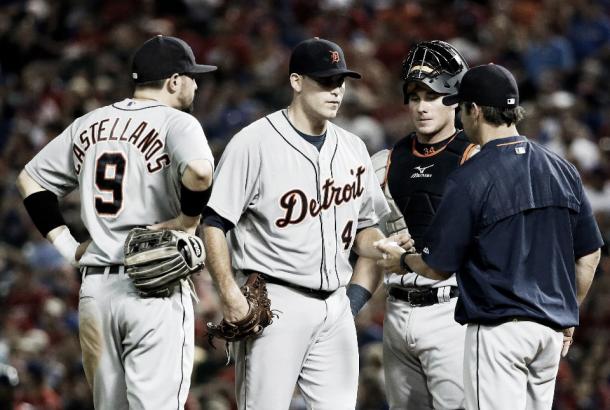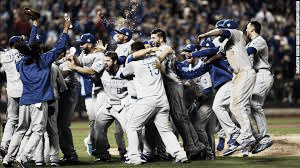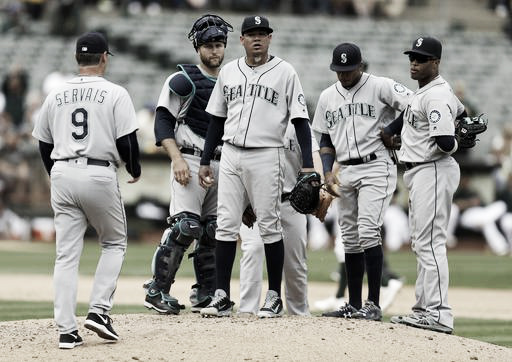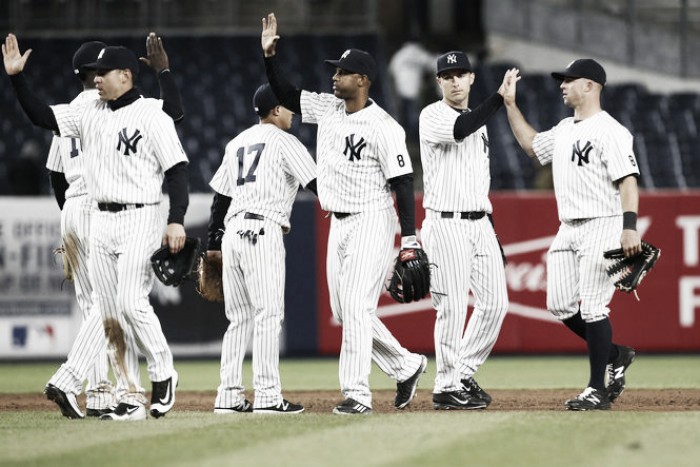Since the implementation of the second wild-card spot in 2012, MLB fans have raved about how many more teams are buyers at the deadline because they are contending for that second spot, granting them a winners-take-all road play-in game. But is it worth it? And for the teams that wouldn't have contended under the previous playoff system, are they actual contenders? Or are they just holding onto the wisp of a faint dream that they might make the playoffs.
For example, last year, the San Diego Padres were 48-53 on July 29, two days before the non-waiver trading deadline. Everyone expected the Padres to be selling at the deadline, because they were eight games out of that second wild card slot, mired in fourth place in the N.L. West. However, shocking everyone, the Padres announced they weren't giving up on the 2015 season and would be buying at the deadline.
How did that pan out for the Padres?
The Padres finished on 26-35 run, finishing in fourth place in the division, eighteen games back of the division lead and a whopping 23 games out of the wildcard. The Padres, like so many other teams, were the victim of thinking they were a contending team because of that wildcard, only to realize they were never more than a .500 team or worse.
So, with that in mind, let's look at this year's 'bubble' teams and see whether they should buy or sell at the deadline.
New York Yankees: Sellers
The Yankees sit just 5.5 games out of the second wild card spot entering play after the All-Star Break, as well as 7.5 games out of the division. The Yankees have been a .500 team all year, never going on enough a streak to be considered a legitimate contender, but never falling so far off the tables to be dismissed from the picture completely. The Yankees have been buyers for so long at the trade deadline, that it is very difficult to imagine the Bronx Bombers selling, but they may just do that come July 31st. Barring a massive hot streak coming out of the break, a streak that escaped them throughout the first three and a half months of the season, the Yankees should sell at the deadline. Whether they choose to do so is yet to be determined, but it would likely be in the best interest of the Yankees to do so.
They haven't done anything to suggest they will win more than 82 or 83 games, which will almost certainly not be enough to garner the wildcard spot. Their best record at any point this season has been 4-2. After losing their next four games, the Yankees would not garner a winning record until June 25, when a 2-1 win over the Minnesota Twins gave them a 37-36 record. They have not been more than two games over .500 all year.
After dropping two of three to start the All-Star Break, the Yankees are under .500 after the Mid-Summer Classic for the first time since 1995. And although they are just 5.5 games out, they have shown no ability to make up ground in any type of race thus far. After falling to 5.5 games out of the division lead after an April 29th loss to the Boston Red Sox, the Yankees have not come any closer to the division lead in the ensuing two and a half months.
New York are projected to win 74 games and, if things go well, to top out around 82 wins. They have so little to gain from shipping away prospects out of an already dry and brittle farm system in order to attempt at an unlikely run for that second wild card spot, which, even if they magically make the wild-card game, could end with one loss and end their hopes. Are those kinds of chances worth destroying what's left of their farm system? However, by selling, they could replenish that ravaged system, getting big returns for some appealing veterans currently sporting the Yankee pinstripes. C.C. Sabathia, Carlos Beltran, Mark Texeira, and Aroldis Chapman could all get big returns for the Yankees, filling up their depleted minor league rosters with prospects that could set the stage for the Yankees to return to their former glory.
Detroit Tigers: Probable Sellers
This is a very tight call. The Tigers are in second place in the A.L. Central, but they are still 6.5 games back of the red-hot Cleveland Indians. The Tigers ended the first half on a 2-5 slide, dropping them from 44-38 to 46-43. And, despite being in second place in a very tight A.L. Central, the Tigers haven't shown that they are a playoff team. Sitting four games out of the second wild card spot, Detroit's pitching has been spotty all season long and their offense, while being quite good, hasn't been strong enough to cover up their staff's struggles. Their peak was six games above .500. And the fact that they have a winning record is honestly quite lucky, seeing as they have actually scored one less run then their opponents this season.
If they play like they did in the first half, the Tigers are projected to finish 81-81, and top out at 84-78. Such records will not bring them closer to the second wild card spot, currently held by the Boston Red Sox and the Toronto Blue Jays, both of whom are on pace for a 91-win season. The only reason they might buy is to give the Indians some competition in the division, but, unless they reach levels they did not unlock in the first half of the season, catching a red-hot Indians squad on pace for a 96-win season is a tall task and quite unlikely. If the Tigers come streaking out of the gate and can close the gap between them and the Indians, as well as narrow the wild-card race, maybe the Tigers should buy. And, in all likelihood, they probably will buy, so as to not surrender a second straight season at the deadline. But, as of now, the wiser idea would likely be for the Tigers to sell a few veterans, get a handful of prospects, and get ready for 2017. They're close, but not quite there.

Chicago White Sox: Probable Sellers
The White Sox started on a red-hot pace; over their first 33 games, they were on pace for 112 wins. Since their 23-10 start, the White Sox have cooled dramatically, unable to push their way out of the mud, stuck in third place, sandwiched by the Tigers and the Kansas City Royals. And, like the Tigers, they currently don't look like a contending team. The general benchmark for a playoff team is to reach the 90-win plateau. The White Sox, since their spectacular sprint out of the gate, are just 22-33, bringing them to just two games over .500. In order to reach 90 wins, the White Sox would have to come close to resurrecting the pace they started the season at, and then hold that pace for over twice the length they did earlier.
Chicago needs to go 45-28 over the remaining stretch, and they just aren't looking capable right now. They could sell underpeforming veterans like Dioner Navarro to contending teams looking to deepen their bench, picking up a couple of decent prospects and gear their team up for a deep run in 2017. They bought to contend this year, but, right now, that isn't looking plausible.

Kansas City Royals: Current Sellers but Possible Buyers
The Royals are the two-time defending A.L. champs and they certainly aren't going down without a fight. Despite just a 46-44 record and a fourth place standing in the A.L. Central, the Royals might be the one team who aren't out of it. For instance, in the second-Wild Card Era, the 2014 Royals are the worst team from the All-Star break to make it into the play-in game. Sporting a .511 winning percentage coming out of the break, the Royals made a late charge, almost capturing the division title, settling for the first wild-card spot and making a run to the World Series.
Their winning percentage right now? .511. Is it a magical number for Kansas City? We'll see. The main reason the Royals could very plausbibly be buyers is because they still have much of the base that has won them consecutive pennants. Unlike the Tigers and White Sox, who rebuilt coming into this season, the Royals boast a core that won them a World Series title and gave them two appearances in the Fall Classic.
However, to be fair, the languishing Royals are currently in the same boat as the Tigers and White Sox. But, at the risk of bringing up that magical 2014 season too many times, the Royals were just one game above .500, sitting at 53-52 on July 30, before streaking in August, even temporarily taking the division lead. So, although logic says the Royals should be sellers, Ned Yost's team might buy, and then try to summon some of that 2014 magic. Because, why not? The Royals have a young core, built for success.
They don't have a ton of veterans to sell at the deadline, so they don't have a lot to gain from becoming self-proclaimed sellers. Barring a Kansas City slump, you'll likely see the Royals buying at the deadline, even if the numbers, which have the Royals on pace for barely 76 wins, suggest otherwise.

Seattle Mariners: Buyers
Despite currently sitting in third place in the A.L. West, the Mariners are one of the few bubble teams who could make a run in the postseason, if they acquire the right pieces at the deadline. Despite a mediocre 46-45 record, the Mariners are a much better team than that. They have scored almost 50 runs more than their opponents, and the Pythagorean Win-Loss Theorem projects the Mariners should have won 50 games over their first 91 contests. They also project the Mariners, with their current team and no new acquisitions, will win 91 games.
If they can add a piece to their beleagured bullpen (maybe Aroldis Chapman?) and maybe an offensive weapon to deepen their bench, or even a catcher to platoon or replace struggling starter Chris Iannetta, the Mariners could easily surpass the 90-win plateau, even if that requires winning 44 of their final 71 games. The Mariners' record is misleading, and, if they buy at the deadline, they certainly have the potential to cause some upheaval in October.

Philadelphia Phillies: Sellers - Don't make the 'Padres Mistake'
The Phillies have to be careful at the deadline. They turned some heads early this season as they stayed right with the top teams in the N.L. East in the early going, sitting in second place with a 22-16 record by mid-May. They fell to 26-26 by the end of May and have slowly dropped away from the wild-card contenders, sitting seven games back of the second wild card spot, after their first three games back after the All-Star Break. They don't want to make the mistake that the Padres did last year.
Last year, because they were closer to the playoff picture than in any of the previous four seasons, the Padres got overexcited and bought at the deadline, when they had very little chance of making it to October baseball. The Phillies should not make the same mistake. Although it is tempting, as they have their best chance of making the postseason in three or four years, the Phillies need to be patient and realize that, with the young talent they have, they could create a dynasty in the years to come. They should not pursue the postseason this year. They have a young lineup that will be battle-tested next year and ready for an October run.
Five of their top six prospects are in AAA ball right now, so the Phillies could give them some experience in September. The Phillies are geared up to be a powerful team in the ensuing years, as long as they don't ruin it by thinking they are contenders this season.

Colorado Rockies: Sellers
The Rockies are similar to the Phillies. They have young, promising talent, but they are not quite ready. The emergence of Trevor Story has been a big story for the Rockies, who, like always, have boasted a prolific offense that has not been supported by a pitching staff that is bad, bordering on horrendous. However, the Rockies have some encouraging news regarding the men on the bump in the hitters-friendly Coors Field.
They've seen some promising young hurlers experience success at the major league level this season, with the likes of Jon Gray, Tyler Chatwood, and Chris Rusin forming the top 3 in the Rockies' rotation. The Rockies also have a plethora of top pitching prospects on the path to Colorado, with four of their top five pitching prospects expected to be MLB-ready by 2017. The Rockies don't have the pitching to back up a run at the postseason this year, but, if they sell a couple of veterans at the deadline this season, and get a good haul in return, much like they did last year, they could be ready for a postseason trip in 2017, which would be their first since 2009.

Having covered the 'bubble teams', it's time to see which teams decide to buy and sell at the deadline. The bubble teams mentioned here were essentially defined as teams between 4-7 games out of the second Wild-Card spot coming out of the All-Star break. The verdicts of whether the team should buy or sell was not just based off how far out the team was, but also the potential the team had, and how unlucky/lucky they had been thus far in the year to accumulate their current record.
Well, one writer has given his opinion. Now let's see what the big men in each team's front office decide to do.






































